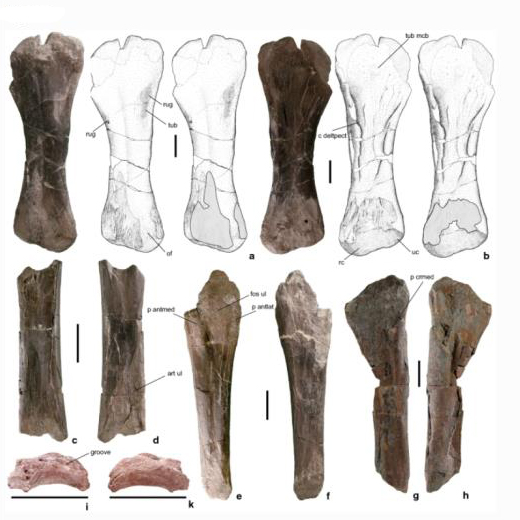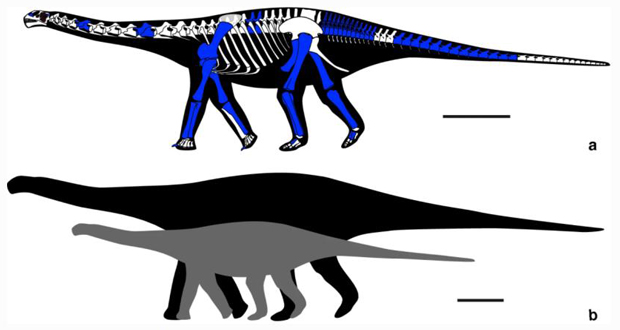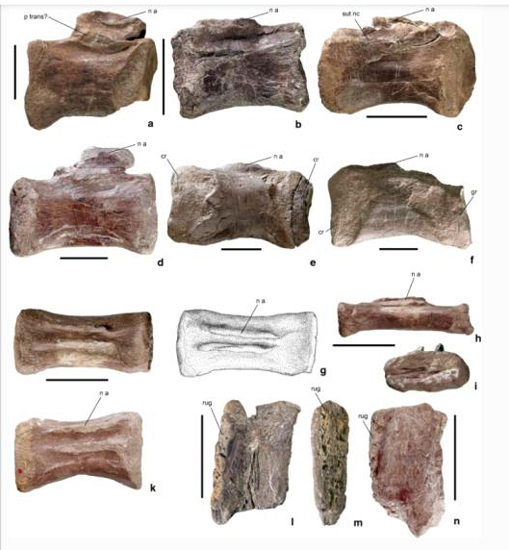The First Sauropod from Switzerland
Amanzia greppini – The First Sauropod Described From Switzerland
Badly distorted and disarticulated dinosaur bones found in the 1860s in north-western Switzerland have led to the establishment of a new genus of European sauropod. Amanzia greppini, described from an assortment of fragmentary fossil material, representing four individuals is the first sauropod to be described from fossil remains found in Switzerland. The fossils come from Upper Jurassic strata which form part of the Reuchenette Formation, they were discovered in a limestone quarry in the Basse Montagne, near the city of Moutier.
Limb Bones of Amazia greppini from the Late Jurassic of Switzerland

Picture credit: Schwarz et al (Swiss Journal of Geosciences)
The bones had been sold to a private collector, but the Swiss geologist Jean-Baptiste Greppin was notified of the find and identified the assortment of distorted and crushed bones as the remains of dinosaurs. In the early 20th century these remains were associated with the English sauropod Cetiosauriscus stewarti known from fossils found in Cambridgeshire. However, an extensive review of the Swiss fossil material conducted by Daniela Schwarz (Museum für Naturkunde, Berlin) and co-workers resulted in a new genus being erected earlier this year.
Kimmeridgian versus Callovian
The researchers who re-visited the Swiss sauropod remains identified a number of unique autapomorphies (distinctive traits) to distinguish their fossils from those of C. stewarti. In addition, the Swiss dinosaur was much smaller, with an estimated maximum length of around ten metres compared to the proposed fifteen metres for Cetiosauriscus. The scientists, which included Philip Mannion (University College London), Oliver Wings (University Halle-Wittenberg in Germany) and Christian Meyer (University of Basel), found differences in the caudal vertebrae (tail bones) as well as difference in the shape and proportions of the femur, humerus and coracoid.
A discrepancy in the geological age between C. stewarti and the Swiss fossil material was also noted. Fossils of Cetiosauriscus stewarti come from strata associated with the Callovian faunal of the Middle Jurassic, whilst the fossils of Amanzia greppini come from geologically younger deposits laid down during the Kimmeridgian faunal stage (Late Jurassic).
Skeletal Reconstruction of Amanzia greppini and Size Comparison with the Geologically Older Cetiosauriscus stewarti

Picture credit: Schwarz et al (Swiss Journal of Geosciences)
Honouring a Famous Swiss Scientist
The genus is named in honour of the well-known Swiss geologist Amanz Gressly (1814–1865) who introduced the term “facies” to describe rock types with different characteristics and discovered the first dinosaur fossil from Switzerland in 1856. The trivial or specific name pays tribute to Jean-Baptiste Greppin, who was the first person to identify the jumbled remains from the quarry as coming from a member of the Dinosauria.
In addition, to the sauropod bones, a single, worn tooth from a sauropod was discovered. This tooth (specimen number NMB M.H. 451), has been assigned to A. greppini. Bones from an ancient marine crocodylomorph and a broken theropod tooth were also found in association with the sauropod remains. Based on the matrix material and the study of ostracod fossils found at the quarry, the scientists concluded that the carcass of Amanzia, was buried in a shallow, temporary lake close to the sea.
Middle and Posterior Caudal Vertebrae with Accompanying Line Drawing (A. greppini)

Picture credit: Schwarz et al (Swiss Journal of Geosciences)
More European Sauropods to Come
When this research was published in the Swiss Journal of Geosciences earlier this year (February 2020), the researchers concluded that the first Swiss sauropod taxon helped to demonstrate the diversity of the sauropods known from the Late Jurassic of Europe. The exact placement of Amanzia greppini within the Sauropoda remains controversial, the authors speculated that it might be a sister taxon to the Neosauropoda or a member of the Turiasauria, a geographically and temporally widespread group of sauropods with a number of European genera such as Cardiodon, Losillasaurus, Zby and Turiasaurus.
They concluded that more fossil discoveries and the reassessment of sauropod fossils held in museum collections would lead to the naming of many more European sauropod genera.
The scientific paper: “Re-description of the sauropod dinosaur Amanzia (“Ornithopsis/Cetiosauriscus”) greppini n. gen. and other vertebrate remains from the Kimmeridgian (Late Jurassic) Reuchenette Formation of Moutier, Switzerland” by Daniela Schwarz, Philip D. Mannion, Oliver Wings and Christian A. Meyer published in the Swiss Journal of Geosciences.
Visit the award-winning Everything Dinosaur website: Everything Dinosaur.

